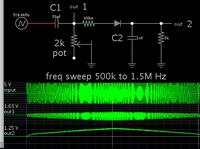bhl777
Full Member level 6
Hi all, I am looking for a frequency to voltage or frequency to current converter, that can process sinusoidal signal around 1MHz. However, I searched in digi-key but did not find any suiatble commercially available ICs to meet this specs. Would anybody recommendate the places I can go to search for this kind of product? This converter is for signal level processing, and ideally I want the VCC be low as 5V or 3.3V.
Thank you!
Thank you!








